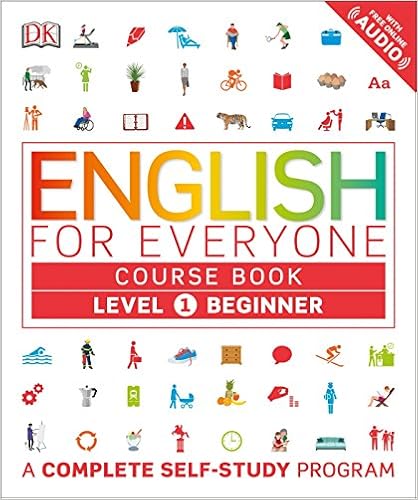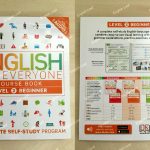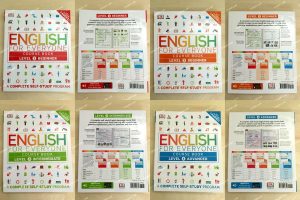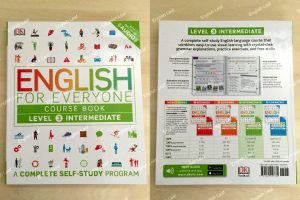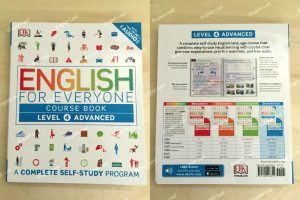様々な目的で使える
「English for Everyone」シリーズのレベル1です。TOEFL・TOEICなど主要の英語試験に必要な語彙や文法、演習がカバーされています。全ての内容が英語で書かれているため、最初から最後まで読むだけでも確実に英語力がアップします。
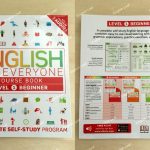
Author
Rachel Harding has a background in English-language teaching and is now a full-time author of English-language learning materials. She has written for major English-language publishers including Oxford University Press.
Course consultant
Tim Bowen has taught English and trained teachers in more than 30 countries worldwide. He is the co-author of works on pronunciation teaching and language-teaching methodology, and author of numerous books for English-language teachers. He is currently a freelance materials writer, editor, and translator. He is a member of the Chartered Institute of Linguists.
Language consultant
Professor Susan Barduhn is an experienced English-language teacher, teacher trainer, and author, who has contributed to numerous publications. In addition to directing English-language courses in at least four different continents, she has been President of the International Association of Teachers of English as a Foreign Language, and an adviser to the British Council and the US State Department. She is currently a Professor at the School for International Training in Vermont, USA.
Penguin Random House
US Editors Allison Singer, Jenny Siklos
Editors Gareth Clark, Lisa Gillespie, Andrew Kerr-Jarrett
Art Editors Chrissy Barnard, Ray Bryant
Senior Art Editor Sharon Spencer
Editorial Assistants Jessica Cawthra, Sarah Edwards
Illustrators Edwood Burn, Denise Joos, Michael Parkin, Jemma Westing
Audio Producer Liz Hammond
Managing Editor Daniel Mills
Managing Art Editor Anna Hall
Project Manager Christine Stroyan
Jacket Designer Natalie Godwin
Jacket Editor Claire Gell
Jacket Design Development Manager Sophia MTT
Producer, Pre-Production Luca Frassinetti
Producer Mary Slater
Publisher Andrew Macintyre
Art Director Karen Self
Publishing Director Jonathan Metcalf
DK India
Jacket Designer Surabhi Wadhwa
Managing Jackets Editor Saloni Singh
Senior DTP Designer Harish Aggarwal
First American Edition, 2016 Published in the United States by DK Publishing 1450 Broadway, Suite 801, New York, NY 10018
Copyright © 2016 Dorling Kindersley Limited DK, a Division of Penguin Random House LLC 109876 031-258528-Jun/2016
All rights reserved. Without limiting the rights under the copyright reserved above, no part of this publication may be reproduced, stored in or introduced into a retrieval system, or transmitted, in any form, or by any means (electronic, mechanical, photocopying, recording, or otherwise), without the prior written permission of the copyright owner. Published in Great Britain by Dorling Kindersley Limited.
A catalog record for this book is available from the Library of Congress. ISBN 978-1-4654-4762-3
DK books are available at special discounts when purchased in bulk for sales promotions, premiums, fund-raising, or educational use. For details, contact: DK Publishing Special Markets, 1450 Broadway, Suite 801, New York, NY 10018
Special Sales@dk.com
Printed and bound in the United States of America
All images © Dorling Kindersley Limited For further information see: www.dkimages.com
A WORLD OF IDEAS: SEE ALL THERE IS TO KNOW
www.dk.com
Contents
How the course works
01 Introducing yourself
New language Using “to be” with names
Vocabulary Names and letters
New skill Saying your name
02 Vocabulary Countries
03 Talking about yourself
New language “To be” with ages and nationalities
Vocabulary Numbers and nationalities
New skill Talking about yourself
04 Vocabulary Family and pets
05 Things you have
New language Possessive adjectives; “this” and “that”
Vocabulary Animals and family
New skill Talking about who things belong to
06 Using apostrophes
New language Possessive apostrophe
Vocabulary Family and pets
New skill Talking about belonging
07 Vocabulary Everyday things
08 Talking about your things
New language “These” and “those”
Vocabulary Possessions
New skill Using determiners and pronouns
09 Vocabulary Jobs
10 Talking about your job
New language Using “I am” for your job
Vocabulary Jobs and workplaces
New skill Describing your job
11 Telling the time
New language Times of day
Vocabulary Words for time
New skill Saying what the time is
12 Vocabulary Daily routines
13 Describing your day
New language The present simple
Vocabulary Routine activities
New skill Talking about your daily routine
14 Describing your week
New language Days and prepositions
Vocabulary Days of the week
New skill Talking about your weekly routine
15 Negatives with “to be”
New language Negatives with “to be”
Vocabulary “Not”
New skill Saying what things are not
16 More negatives
New language Present simple negative
Vocabulary Daily activities
New skill Saying what you don’t do
17 Simple questions
New language Simple questions
Vocabulary Jobs and routine activities
New skill Asking simple questions
18 Answering questions
New language Short answers
Vocabulary Jobs and routines
New skill Answering spoken questions
19 Asking questions
New language Open questions
Vocabulary Question words
New skill Asking for details
20 Vocabulary Around town
21 Talking about your town
New language “There is” and “there are”
Vocabulary Towns and buildings
New skill Describing a town
22 Using “a” and “the”
New language Definite and indefinite articles
Vocabulary Places in town
New skill Using articles
23 Orders and directions
New language Imperatives
Vocabulary Directions
New skill Finding your way
24 Joining sentences
New language Using “and” and “but”
Vocabulary Town, jobs, and family
New skill Joining sentences
25 Describing places
New language Adjectives
Vocabulary Place adjectives and nouns
New skill Describing places
26 Giving reasons
New language “Because”
Vocabulary Places and jobs
New skill Giving reasons
27 Vocabulary Around the house
28 The things I have
New language Using “have”
Vocabulary Household objects
New skill Talking about possessions
29 What do you have?
New language “Have” questions
Vocabulary House and furniture
New skill Asking about household objects
30 Vocabulary Food and drink
31 Counting
New language Uncountable nouns
Vocabulary Food containers
New skill Talking about food
32 Measuring
New language Measurements
Vocabulary Ingredients and quantities
New skill Talking about amounts
33 Vocabulary Clothes
34 At the shops
New language Using “too” and “fit”
Vocabulary Shopping and clothes
New skill Describing clothes
35 Describing things
New language Opinion adjectives
Vocabulary Shopping and materials
New skill Giving opinions
36 Vocabulary Sports
37 Talking about sports
New language “Go” and “play”
Vocabulary Sports
New skill Talking about sports
38 Vocabulary Hobbies and pastimes
39 Free time
New language Adverbs of frequency
Vocabulary Pastimes
New skill Talking about your free time
40 Likes and dislikes
New language “Love,” “like,” and “hate”
Vocabulary Food, sports, and pastimes
New skill Talking about what you like
41 Vocabulary Music
42 Expressing preference
New language Using “favorite”
Vocabulary Food and music
New skill Talking about your favorite things
43 Vocabulary Abilities
44 What you can and can’t do
New language “Can,” “can’t,” and “cannot”
Vocabulary Talents and abilities
New skill Saying what you can and can’t do
45 Describing actions
New language Regular and irregular adverbs
Vocabulary Hobbies and activities
New skill Describing activities
46 Describing ability
New language Modifying adverbs
Vocabulary Skills and abilities
New skill Saying how well you do things
47 Wishes and desires
New language “Would” and “want”
Vocabulary Leisure activities
New skill Talking about ambitions
48 Studying
New language Adverbs and articles
Vocabulary Academic subjects
New skill Talking about your studies
Answers
Index
How the course works
English for Everyone is designed for people who want to teach themselves the English language. Like all language courses, it covers the core skills: grammar, vocabulary, pronunciation, listening, speaking, reading, and writing. Unlike in other courses, the skills are taught and practiced as visually as possible, using images and graphics to help you understand and remember. The best way to learn is to work through the book in order, making full use of the audio available on the website and app. Turn to the practice book at the end of each unit to reinforce your learning with additional exercises.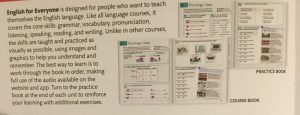
Unit number The book is divided into units. The unit number helps you keep track of your progress.
Learning points Every unit begins with a summary of the key learning points.
Modules Each unit is broken down into modules, which should be done in order. You can take a break from learning after completing any module.
Language learning Modules with colored backgrounds teach new vocabulary and grammar.
Study these carefully before moving on to the exercises.
Audio support Most modules have supporting audio recordings of native English speakers to help you improve your speaking and listening skills.
Exercises Modules with white backgrounds contain exercises that help you practice your new skills to reinforce learning.
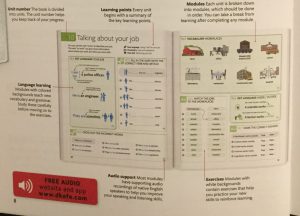
FREE AUDIO
website and app
www.dkefe.com
Language modules
New language points are taught in carefully graded stages, starting with a simple explanation of when they are used, then offering further examples of common usage and a detailed breakdown of how key constructions are formed.
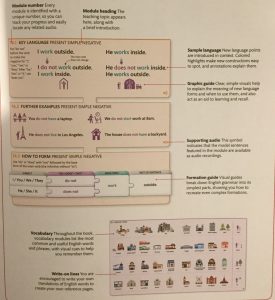
Module number Every module is identified with a unique number, so you can track your progress and easily locate any related audio.
Module heading The teaching topic appears here, along with a brief introduction.
Sample language New language points are introduced in context. Colored highlights make new constructions easy to spot, and annotations explain them.
Graphic guide Clear, simple visuals help to explain the meaning of new language forms and when to use them, and also act as an aid to learning and recall.
Supporting audio This symbol indicates that the model sentences featured in the module are available as audio recordings.
Formation guide Visual guides break down English grammar into its simplest parts, showing you how to recreate even complex formations.
Vocabulary Throughout the book, vocabulary modules list the most common and useful English words and phrases, with visual cues to help you remember them.
Write-on lines You are encouraged to write your own translations of English words to create your own reference pages.
Practice modules
Each exercise is carefully graded to drill and test the language taught in the corresponding course book units. Working through the exercises alongside the course book will help you remember what you have learned and become more fluent. Every exercise is introduced with a symbol to indicate which skill is being practiced.
GRAMMAR Apply new language rules in different contexts.
VOCABULARY Cement your understanding of key vocabulary.
SPEAKING Compare your spoken English to model audio recordings.
READING Examine target language in real-life English contexts.
LISTENING Test your understanding of spoken English

Module number Every module is identified with a unique number, so you can easily locate answers and related audio.
Exercise instruction Every exercise is introduced with a brief instruction, telling you what you need to do.
Sample answer the first question of each exercise is answered for you, to help make the task easy to understand.
Space for writing You are encouraged to write your answers in the book for future reference.
Supporting graphics Visual cues are given to help you understand the exercises.
Supporting audio This symbol shows that the answers to the exercise are available as audio tracks. Listen to them after completing the exercise.
Listening exercise This symbol indicates that you should listen to an audio track in order to answer the questions in the exercise.
Speaking exercise This symbol indicates that you should say your answers out loud, then compare them to model recordings included in your audio files.
Audio
English for Everyone features extensive supporting audio materials. You are encouraged to use them as much as you can, to improve your understanding of spoken English, and to make your own accent and pronunciation more natural. Each file can be played, paused, and repeated as often as you like, until you are confident you understand what has been said.

LISTENING EXERCISES This symbol indicates that you should listen to an audio track in order to answer the questions in the exercise.
SUPPORTING AUDIO This symbol indicates that extra audio material is available for you to listen to after completing the module.
FREE AUDIO website and app www.dkefe.com
Track your progress
The course is designed to make it easy to monitor your progress, with regular summary and review modules. Answers are provided for every exercise, so you can see how well you have understood each teaching point.
Checklists Every unit ends with a checklist, where you can check off the new skills you have learned.
Review modules At the end of a group of units, you will find a more detailed review module, summarizing the language you have learned.
Check boxes Use these boxes to mark the skills you feel comfortable with. Go back and review anything you feel you need to practice further.
Answers Find the answers to every exercise printed at the back of the book.
Exercise numbers Match these numbers to the unique identifier at the top-left corner of each exercise.
Audio This symbol indicates that the answers can also be listened to.



